-

人教版高中历史必修2古代手工业的进步说课稿2篇
【教学方法】教法:讲授法、探究教学法、讲述法、谈话法、比较法学法:接受性学习法、探究性学习法、合作学习法、引导学生自主学习;通过阅读史料,分析历史问题;【教学重点】掌握中国古代手工业发展的基本史实:古代手工业的重要成就;官营手工业产品精美,品种繁多,享誉世界;民营手工业艰难发展,后来居上;家庭手工业是中国古代社会稳定的重要因素。【教学难点】中国古代手工业发展的特征。【教学媒体】多媒体、图片、视频【课型】综合课【导入新课】在05.7.13日伦敦佳士德的一场名为“中国瓷器、手工艺品及外贸产品的拍卖会上,一只绘有“鬼谷下山”图的元代青花瓷罐,被一美国古董商以1656万英镑也就是约2.45亿人民币的价格投得,为什么我们古代的手工业精品在今天如此受人青睐呢?这些价值连城的青铜器、瓷器是什么时候就产生了的,经历了一个怎样的发展历程?今天我们就来解开这些谜底。下面,我们一起学习第2课《古代手工业的进步》。
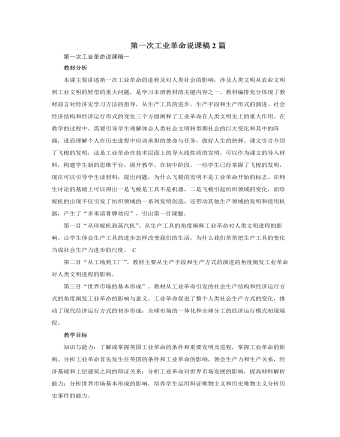
人教版高中历史必修2第一次工业革命说课稿2篇
3、工业革命引起社会关系变化——形成两大对立的工业资产阶级和无产阶级工业资产阶级和工业无产阶级成为社会的两大阶级。工业资产阶级获得更多的政治权利,各国通过改革,巩固了资产阶级的统治。 4、工业革命推动资产阶级调整内外政策——自由主义与殖民扩张对内,希望进一步摆脱封建束缚,要求自由经营、自由竞争和自由贸易。重商主义被自由放任政策所取代。对外,加快了殖民扩张和殖民掠夺的步伐。三、世界市场的基本形成1、原因条件(1)工业革命的展开使世界贸易的范围和规模迅速扩大1840年前后,英国的大机器工业基本上取代了工场手工业,率先完成了工业革命,成为世界上第一个工业国家。之后,法国和美国等国也相继完成工业革命。随着工业革命的展开,资产阶级竭力在全世界拓展市场,抢占原料产地,使世界贸易的范围和规模迅速扩大。
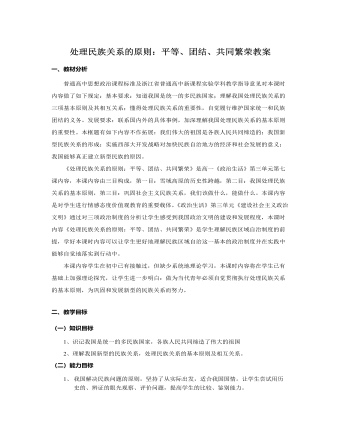
人教版高中政治必修2处理民族关系的原则:平等、团结、共同繁荣教案
一、教材分析普通高中思想政治课程标准及浙江省普通高中新课程实验学科教学指导意见对本课时内容做了如下规定:基本要求:知道我国是统一的多民族国家;理解我国处理民族关系的三项基本原则及其相互关系;懂得处理民族关系的重要性,自觉履行维护国家统一和民族团结的义务。发展要求:联系国内外的具体事例,加深理解我国处理民族关系的基本原则的重要性。本框题有如下内容不作拓展:我们伟大的祖国是各族人民共同缔造的;我国新型民族关系的形成;实施西部大开发战略对加快民族自治地方的经济和社会发展的意义;我国能够真正建立新型民族的原因。《处理民族关系的原则:平等、团结、共同繁荣》是高一《政治生活》第三单元第七课内容,本课内容由三目构成,第一目:雪域高原的历史性跨越,第二目:我国处理民族关系的基本原则,第三目:巩固社会主义民族关系,我们该做什么,能做什么。
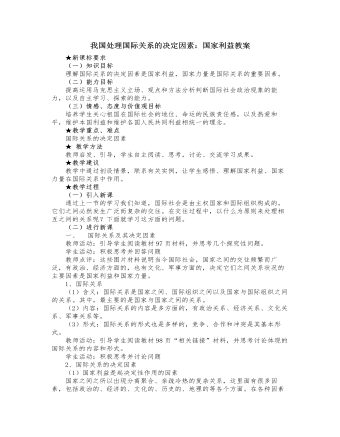
人教版高中政治必修2我国处理国际关系的决定因素:国家利益教案
从国际法角度看,国际社会的每一个主权国家应该是一律平等的,但是,在现实的国际关系中,每个国家的国际地位、国际影响力,历来都是由国家力量决定的。国家力量发生变化,也会引起国际关系的变化。经济、科技落后,军力不强,国内政局不安,它的国际影响力、参与力就不强。正因为如此,某些发达国家往往以其强大的国家力量为后盾,推行霸权主义、强权政治。二、维护我国的国家利益教师活动:阅读教材第100页内容,思考讨论为什么要维护我国的国家利益?我国的国家利益包括哪些内容?学生活动:认真思考并积极讨论,踊跃发言1、原因我国是人民当家作主的社会主义国家,国家利益与人民的根本利益相一致。维护我国的国家利益就是维护广大人民的根本利益,具有正当性和正义性。2、内容我国国家利益的主要内容包括:安全利益,如国家的统一、独立、主权和领土完整;政治利益,如我国政治、经济、文化等制度的巩固;经济利益,如我国资源利用的效益、经济活动的利益和国家物质基础的增强等。
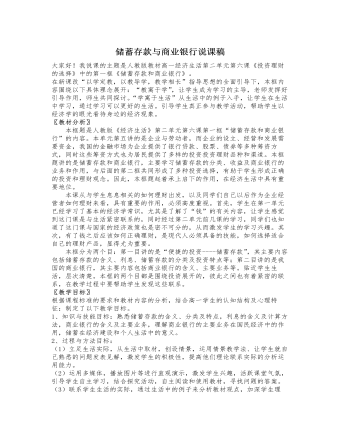
人教版高中政治必修1储蓄存款与商业银行说课稿
(一)储蓄存款1、储蓄存款的含义:讲解时让学生明白几个要点----谁在存?存什么?往哪存?有什么凭证?为什么存?并强调居民存款必须是合法拥有的,而且是有偿的。明确含义之后通过案例引导学生思考,人们都到哪些地方存款?学生活动:可以存入农业银行、建设银行、中国银行、工商银行信用合作社,邮政储蓄等;2、通过学生回答,我国的主要储蓄机构是各商业银行,并引导学生思考人们为什么将钱存入储蓄机构?储蓄的目的是什么?(可获得利息)从而引出3、利息含义及其计算公式,并熟悉利息计算公式4、提出问题:储蓄种类----定期,活期,让学生对比两种储蓄的异同并填表格。(二)我国的商业银行首先展示一组银行图标引导学生思考,哪些银行属于商业银行,从而引出第一个小问题----商业银行的含义。讲解定义,让学生抓住商业银行的业务和经营目标。

必修一牛顿第一定律教案
(二)?过程与方法? 4.?观察生活中的惯性现象,了解力和运动的关系? 5.?通过实验加深对牛顿第一定律的理解? 6.?理解理想实验是科学研究的重要方法? (三)?情感态度与价值观? 7.?通过伽利略和亚里士多德对力和运动关系的不同认识,了解人类认识事物本质的曲折性? 8.?感悟科学是人类进步的不竭动力

高中思想政治人教版必修四《哲学史上的伟大变革活动探究型》教案
一、教材分析人教版高中思想政治必修4生活与哲学第一单元第三课第二框题《哲学史上的伟大变革》。本框主要内容有马克思主义哲学的产生和它的基本特征、马克思主义的中国化的三大理论成果。学习本框内容对学生来讲,将有助于他们正确认识马克思主义,运用马克思主义中国化的理论成果,分析解决遇到的社会问题。具有很强的现实指导意义。二、学情分析高二学生已经具备了一定的历史知识,思维能力有一定提高,思想活跃,处于世界观、人生观形成时期,对一些社会现象能主动思考,但尚需正确加以引导,激发学生学习马克思主义哲学的兴趣。三、教学目标1.马克思主义哲学产生的阶级基础、自然科学基础和理论来源,马克思主义哲学的基本特征。2.通过对马克思主义哲学的产生和基本特征的学习,培养学生鉴别理论是非的能力,进而运用马克思主义哲学的基本观点分析和解决生活实践中的问题。3.实践的观点是马克思主义哲学的首要和基本的观点,培养学生在实践中分析问题和解决问题的能力,进而培养学生在实践活动中的科学探索精神和革命批判精神。

人教版高中政治必修3传统文化的继承说课稿
只有对儒家的价值作出客观、公正、全面的评价,才可能避免陷入文化虚无主义或文化复古主义的误区,合理地、充分地开发利用儒学乃至整个国学的资源为现代社会服务,为促进我国经济发展服务。运用所学知识,谈谈对待儒学我们应该持有的态度。答案:(1)儒学是我国传统文化中一个非常重要的组成部分。传统文化具有相对稳定性,它的内涵又能够因时而变,因此,我们对待儒学的正确态度应该是“取其精华,去其糟粕,批判继承,古为今用”。(2)面对儒学,我们要辩证地认识它在现实生活中的作用,分辨其中的精华和糟粕。对于其中符合社会发展要求的、积极向上的内容,应该继续保持和发扬,使其为社会主义现代化建设服务;对于其中不符合社会发展要求的、落后的、腐朽的东西,必须“移风易俗”,自觉地加以改造和剔除。(五)作业布置传统文化的作用是什么?如何正确对待传统文化?

新人教版高中英语必修3Unit 1 Festivals and Celebrations教学设计二
1. Ss look at the picture and scan the passage to understand the main idea while teacher is giving the following questions to inspire Ss to think.*Where are those people?*What are they doing?*Why are they so excited?2. Ss complete the passage with the appropriate -ing form. Then discuss and check the answers with class.Answers: boring, interesting, taking, exciting, amazing3. The teacher raises questions for the students to discuss and encourages them to express their opinions.*Do you like La Tomatina? Why or why not?4. Each group representative reports the discussion result, the teacher gives feedback and the evaluation.Step 6 PracticeActivity 41. Ss complete the Ex 2 in Using structures.2. Check the answers after finishing the exercises.①The dragon boat races are the most exciting part of the Dragon Boat Festival.② The children were excited to go Easter egg hunting.③What an amazing performance! This is the best music festival I have ever been to.④We were amazed by her funny-looking hat.⑤His inspiring speech at the conference won the admiration/ favour of the audience.⑥This is a challenging game to test your memory and observation capabilities. 3. T asks Ss to finish Ex 3 and 4 in Using structures by themselves, then check the answers with class.Step 6 Homework1. Understand and master the functions and usage of the -ing form;2. Finish the other exercises in Using structures.1、通过本节内容学习,学生是否理解和掌握动词-ing形式作定语和表语的功能和意义;2、通过本节内容学习,学生能否在理解文段内容的基础上,根据上下文语境和表达逻辑,能正确运用动词-ing形式描述节日庆典。3、通过本节内容学习,学生是否归纳和积累用于表达情绪的相关词汇。

新人教版高中英语必修3Unit 3 Diverse Cultures教学设计三
The price is the same as(the price was)before the war.价格与战前相同。(4)定语从句中的“关系代词+助动词be”可以省略。The ticket(that/which was)booked by his sister has been sent to him.他妹妹订的那张票已送到了他那里。Step 5 PracticeActivity 3(1) Guide students to complete the four activities in the Using Structures part of exercise book, in which activities 1 and 2 focus on ellipsis in dialogue answers, activity 3 focus on signs and headlines, two typical situations where ellipsis is used, and activity 4 focus on ellipsis in diary, an informal style.(2) Combine the examples in the above activities, ask students to summarize the omitted situations in groups, and make their own summary into a poster, and post it on the class wall after class to share with the class.(This step should give full play to the subjectivity of students, and teachers should encourage students to conclude different ellipsis phenomena according to their own understanding, they can conclude according to the different parts omitted in the sentence.)Step 6 Homework1. Understand and master the usages of ellipsis;2. Finish the other exercises in Using structures of Workbook.1、通过本节内容学习,学生是否理解和掌握省略的用法;2、通过本节内容学习,学生能否根据上下文语境或情景恢复句子中省略的成分,体会使用省略的效果;3、通过本节内容学习,学生能否独立完成练习册和导学案中的相关练习。

新人教版高中英语必修3Unit 3 Diverse Cultures教学设计四
该板块的活动主题是“介绍一个有显著文化特征的地方”( Describe a place with distinctive cultural identity)。该板块通过介绍中国城继续聚焦中国文化。本单元主题图呈现的是旧金山中国城的典型景象, Reading and Thinking部分也提到中国城,为该板块作铺垫。介绍中国城的目的主要是体现中国文化与美国多元文化的关系,它是美国多元文化的重要组成部分。中国城也是海外华人的精神家园和传播中国文化的重要窗口,外国人在中国城能近距离体验中国文化。1. Read the text to understand the cultural characteristics of Chinatown in San Francisco and the relationship between Chinese culture and American multiculturalism;2. Through reading, learn to comb the main information of the article, understand the author's writing purpose and writing characteristics;3. Learn to give a comprehensive, accurate, and organized description of the city or town you live in;Learn to revise and evaluate your writing.Importance:1. Guide the students to read the introduction of Chinatown in San Francisco and grasp its writing characteristics;2. Guide students to introduce their city or town in a comprehensive, accurate and organized way;3. Learn to comb the main information of the article, understand the author's writing purpose, and master the core vocabulary.

新人教版高中英语必修3Unit 3 Diverse Cultures教学设计一
Activity 81.Grasp the main idea of the listening.Listen to the tape and answer the following questions:Who are the two speakers in the listening? What is their relationship?What is the main idea of the first part of the listening? How about the second part?2.Complete the passage.Ask the students to quickly review the summaries of the two listening materials in activity 2. Then play the recording for the second time.Ask them to complete the passage and fill in the blanks.3.Play the recording again and ask the students to use the structure diagram to comb the information structure in the listening.(While listening, take notes. Capture key information quickly and accurately.)Step 8 Talking Activity 91.Focus on the listening text.Listen to the students and listen to the tape. Let them understand the attitudes of Wu Yue and Justin in the conversation.How does Wu Yue feel about Chinese minority cultures?What does Justin think of the Miao and Dong cultures?How do you know that?2.learn functional items that express concerns.Ask students to focus on the expressions listed in activity. 3.And try to analyze the meaning they convey, including praise (Super!).Agree (Exactly!)"(You're kidding.!)Tell me more about it. Tell me more about it.For example, "Yeah Sure." "Definitely!" "Certainly!" "No kidding!" "No wonder!" and so on.4.Ask the students to have conversations in small groups, acting as Jsim and his friends.Justin shares his travels in Guizhou with friends and his thoughts;Justin's friends should give appropriate feedback, express their interest in relevant information, and ask for information when necessary.In order to enrich the dialogue, teachers can expand and supplement the introduction of Miao, dong, Lusheng and Dong Dage.After the group practice, the teacher can choose several groups of students to show, and let the rest of the students listen carefully, after listening to the best performance of the group, and give at least two reasons.

新人教版高中英语必修3Unit 1 Festivals and Celebrations教学设计一
本板块的活动主题是“谈论节日活动”(Talk about festival activities),主要是从贴近学生日常生活的角度来切入“节日”主题。学生会听到发生在三个国家不同节日场景下的简短对话,对话中的人们正在参与或将要亲历不同的庆祝活动。随着全球化的进程加速,国际交流日益频繁,无论是国人走出国门还是外国友人访问中国,都已成为司空见惯的事情。因此,该板块所选取的三个典型节日场景都是属于跨文化交际语境,不仅每组对话中的人物来自不同的文化背景,对话者的身份和关系也不尽相同。1. Master the new words related to holiday: the lantern, Carnival, costume, dress(sb)up, march, congratulation, congratulate, riddle, ceremony, samba, make - up, after all. 2. To understand the origin of major world festivals and the activities held to celebrate them and the significance of these activities;3. Improve listening comprehension and oral expression of the topic by listening and talking about traditional festivals around the world;4. Improve my understanding of the topic by watching pictures and videos about different traditional festivals around the world;5. Review the common assimilation phenomenon in English phonetics, can distinguish the assimilated phonemes in the natural language flow, and consciously use the assimilation skill in oral expression. Importance:1. Guide students to pay attention to the attitude of the speaker in the process of listening, and identify the relationship between the characters;2. Inspire students to use topic words to describe the festival activities based on their background knowledge. Difficulties:In the process of listening to the correct understanding of the speaker's attitude, accurately identify the relationship between the characters.

新人教版高中英语必修3Unit 1 Festivals and Celebrations教学设计三
*wide range of origins(= a great number of different origins, many kinds of origins)*It featured a parade and a great feast with music, dancing, and sports. (=A parade and a great feast with music, dancing, and sports were included as important parts of the Egyptian harvest festival.)*.. some traditions may fade away and others may be established.(= Some traditions may disappear gradually, while other new traditions may come into being.)Step 6 Practice(1) Listen and follow the tape.The teacher may remind the students to pay attention to the meaning and usage of the black words in the context, so as to prepare for the completion of the blanks in activity 5 and vocabulary exercises in the exercise book.(2) Students complete the text of activity 5 by themselves.The teacher needs to remind the students to fill in the blanks with the correct form of the vocabulary they have learned in the text.Students exchange their answers with their partners, and then teachers and students check their answers.(3)Finish the Ex in Activity 5 of students’ book.Step 7 Homework1. Read the text again, in-depth understanding of the text;2. Discuss the origin of festivals, the historical changes of related customs, the influence of commercial society on festivals and the connotation and essential meaning of festivals.3. Complete relevant exercises in the guide plan.1、通过本节内容学习,学生是否理解和掌握阅读文本中的新词汇的意义与用法;2、通过本节内容学习,学生能否结合文本特点快速而准确地找到主题句;3、通过本节内容学习,学生能否理清论说文的语篇结构和文本逻辑,了解节日风俗发展与变迁,感悟节日的内涵与意义。

新人教版高中英语必修3Unit 3 Diverse Cultures教学设计二
(2)Consolidate key vocabulary.Ask the students to complete the exercises of activity 6 by themselves. Then ask them to check the answers with their partners.(The first language:Damage of the 1906 San Francisco earthquake and fire.A second language: Yunnan - one of the most diverse provinces in China).Step 5 Language points1. The teacher asks the students to read the text carefully, find out the more words and long and difficult sentences in the text and draw lines, understand the use of vocabulary, and analyze the structure of long and difficult sentences.2. The teacher explains and summarizes the usage of core vocabulary and asks the students to take notes.3. The teacher analyzes and explains the long and difficult sentences that the students don't understand, so that the students can understand them better.Step 6 Homework1. Read the text again, in-depth understanding of the text;2. Master the use of core vocabulary and understand the long and difficult sentences.3. Complete relevant exercises in the guide plan.1、通过本节内容学习,学生是否理解和掌握阅读文本中的新词汇的意义与用法;2、通过本节内容学习,学生能否结合文本特点了解文章的结构和作者的写作逻辑;3、通过本节内容学习,学生能否了解旧金山的城市风貌、文化特色,以及加利福尼亚州的历史,体会多元文化对美国的影响。

人教版高中政治必修1新时代的劳动者说课稿
第一环节:关于劳动光荣和就业的意义。这两个问题学生在自主阅读的基础上,教师设疑,给出两个人物事迹,一是农民工刘俊刚把青春献给第二个家乡的城市美容师;一是北大学子李彦宏自主创业,创建百度公司,启发学生比较、思考。很多学生倾向于要做李彦宏,教师则适时引导:难道清洁工的劳动不重要吗?经过辩论,归纳出劳动和就业的意义。接着利用教材中李师傅的事例,进行问题探究,“李师傅找不到工作的原因是什么?”从主客观两方面分析,带着问题进入到下一环节学习。第二环节:突出重点。多媒体展示:通过数字的列举及对占有材料的分析,既看到了我国就业形势严峻,也介绍了国家关注民生,实施积极的就业政策。在此基础上,教师启发学生归纳“我国就业严峻的原因及对策?”学生把教材理论与生活中的现实材料相结合,进行探究,得出就业形势严峻的主要原因及其相应对策。

人教版高中生物必修2人类遗传病说课稿
一、人类遗传病1.概念2.分类(1)单基因遗传病(2)多基因遗传病(3)染色体异常遗传病①原因②类型3遗传病的特点4.遗传病对人类的危害八、说布置作业在作业的布置中,我严格遵循“重质量、轻负担”的指导思想。第一题主要是为了帮助学生及时纠正原有的对知识的错误理解或片面认识,培养学生的解题技巧和技能。所以我选用了该题。同时想借助该题培养学生对问题的科学的思维方法和探究的精神。帮助学生提高对信息技术运用的熟练程度,发展学生的信息素养。附作业:1、连线题,请同学们连线指出下列遗传各属于何种类型?(1)苯丙酮尿病 A、单基因遗传病(2)21三体综合征(3)抗维生素D佝偻病 B、多基因遗传病(4)软骨发育不全(5)青少年型糖尿病 C、常染色体病2、以生物小组为单位进行人类遗传病的调查。
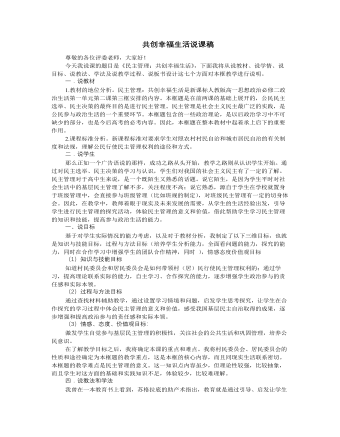
人教版高中政治必修2共创幸福生活说课稿
环节三 案例分析 突破难点我将用多媒体展示两组反映中学生参与民主管理的一些作法的图片,和教材26-27页的三个镜头,然后请同学们根据图片和材料探究以下问题: 1. 联系自身实际谈谈这些做法对我们有何启示? 2.实行农村村民自治和城市居民自治有什么意义呢? 3. 我们在实际生活中应怎么做?这样,通过图片和材料的展示,点明了公民参与民主管理的意义,以此来诱发学生已有的真切体验,感受其境,增强学生共创想和文明社区的积极性和情感。同时,我们也希望学生在学习本课的知识后,又能做到学以致用,把所学的知识真正用到社区管理中,为所在社区管理提合理建议,从而真正实现了知识从生活中来,又回到生活中去的理念。环节四课堂小结 课后延伸将用多媒体展示本节课的知识框架,并注重引导学生将今天所学新知识与前面知识联系起来,帮助学生从宏观上把握各知识点之间的关系,有利于学生理解记忆,以此来帮助教师在第一时间掌握学生学习信息的反馈,同时培养学生归纳分析能力、概括能力。

人教版高中历史必修2大众传媒的变迁说课稿
教学内容与分析本课内容是大众传媒的变迁,首先解题,了解什么是大众传媒。大众传媒就是传播大众信息的媒体,进入近代社会以来,人与人之间的联系变得越来越密切,社会化程度大大加深,需要有一种大众化、传播速度快、传播范围广的媒介作为人与人之间进行信息沟通的渠道,人类社会的传媒手段应运而生,可由学生总结出有哪些主要的方式。报刊、影视、广播,这三种大众传播媒体的依次出现,给人们的生活方式带来了巨大的变化,被称为三大媒介。由于互联网同报纸、广播和电视三大媒介一样,具有传播信息的功能,所以被称为“第四媒介”,即“网络媒介”。通过本节课的学习使学生了解中国近代社会生活的变化,体会历史和时代发展的必然性,能够站在发展的角度、用历史的眼光思考问题。

人教版高中生物必修2伴性遗传说课稿
(1观察图解,色盲基因在性别间是如何传递的呢?(女--女、女--男、男--女)(2)为什么不能由男性传给男性?(色盲基因是在X染色体上,因此色盲基因是随X染色体的传递而传递。)(3)男性的色盲基因怎样才能传给男性呢?(通过女儿,传给外孙即交叉遗传)(4)从图解看色盲在男女中的发病情况怎样?(男性多于女性)(5)从社会调查也是这样,你是否能从基因和染色体的角度加以解释?(提示:女性染色体的构成,结合基因位置及显隐性进行分析)归纳特点:归纳出色盲基因遗传的特点并扩展到X染色体隐性遗传的特点上。色盲基因遗传(X隐性遗传)的特点:(1)男患者多于女患者(2)交叉遗传(3)女病儿子必病,男正女儿必正等。问题探讨:利用“遗传图解”结合“问题链”继续探讨,拓展到抗维生素D即X 染色体显性遗传的特点。(6)色盲基因在X染色体上属隐性基因,子代表现男多于女,对应的正常色觉基因则属于X显性基因,子代表现应如何?(女多于男)